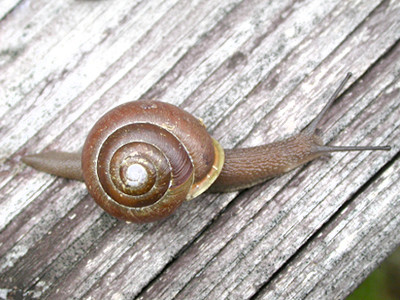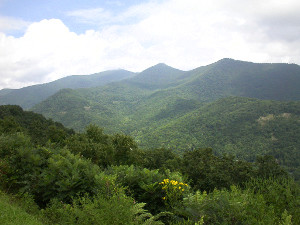Wandering globe snail, Mesodon altivagus (Pilsbry, 1900)
by John D. Slapcinsky

This large and beautiful snail is found in only one patch of spruce-fir and northern hardwood forest above 1500 meters on the highest summits of the Great Smoky Mountains. In the southern US spruce-fir forest is dominated by Fraser Fir (Abies fraseri) and Red Spruce (Picea rubens), and limited to disjunct high elevation peaks in the southern Appalachian Mountains. These forests are the last vestiges of Boreal forests that once covered much of the southern US during the last ice age. As North America warmed spruce fir forests retreated northward and into high elevation refuges.

Mesodon altivagus faces several threats, including global warming, soil acidification, and damage or loss of their spruce-fir forest habitats. In the mid 1980’s the species was so common at Clingman’s Dome in the Smokies that after rains it was difficult to avoid stepping on them. However, during the past 25 years populations appear to have plummeted. Air quality at higher elevations in the southern Appalachians has changed dramatically in the last half century. Moist air acidified by sulfur compounds from coal burning power plants and car exhaust, often from hundreds of kilometers away, drifts over the mountains. Mist derived from acidified clouds at higher elevations can have a pH as low as 3, or as acidic as carbonated drinks. Minerals like calcium carbonate, which snails use to build their shell, are leached from the soil by acidic precipitation. Nutrient leaching also impacts canopy tree species like spruce and fir, and may play a role in the decline of Fraser Fir. Logging during the early 1900’s cleared more than two thirds of the forest in the Smoky Mountains. Loss of forest cover prompted reforestation efforts, some of which unfortunately included exotic trees. The European balsam woolly adelgid (Adelges piceae), a catastrophic pest to these forests, was likely introduced with these exotic trees.. By the 1990’s nearly all mature fir trees in Southern Spruce-Fir forests had succumbed to Adelges infestation and died, opening large portions of the formerly dense canopy and exposing the remaining red spruce to mortality from sudden exposure. A more open canopy likely also impacts soil invertebrates, by leading to changes in soil moisture and leaf litter cover. These changes might have exacerbated snail decline, as acid rain reduces the availability of calcium carbonate for building moisture retaining shells.The decline of spruce-fir forest and the large and showy snail Mesodon altivagus is a “canary in the coal mine,” warning of catastrophic changes to our environment.